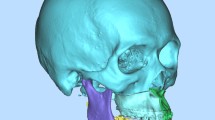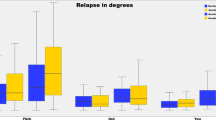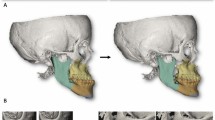Abstract
Objectives
The aim of the present study was to compare conventional (CSP) versus customized virtual surgical planning (VSP) in bimaxillary orthognathic surgery. The primary goal was to compare the accuracy of defined angles. The secondary purpose was to analyze the accuracy of the splints, the time required for surgery, and the costs of both methods.
Materials and methods
A total of 21 patients (nCSP = 12; nVSP = 9) treated by two-jaw orthognathic surgery were analyzed prospectively between the years 2014 and 2016. Customized VSP consisted of virtual planning as well as CAD/CAM printing of splints and pre-bent osteosynthesis plates. The evaluated parameters were the difference between planned and postoperative situation (SNA/SNB/ANB), accuracy of splints, time required for surgery (min), and total costs of planning (€).
Results
When compared to CSP, VSP appears to be a more accurate method for orthognathic treatment planning with significant differences in the angle outcome (SNA p < 0.001; SNB p = 0.002; ANB p < 0.001). There were significant differences in splint accuracy in favor of CAD/CAM splints (p = 0.007). VSP significantly reduced the duration of operation (p = 0.041). Nevertheless, VSP increased the total costs (481.80 € vs. 884.00 €).
Conclusions
When using virtual 3D technology in combination with printed acrylic splints, 3D models of the jaws and pre-bent osteosynthesis, there is a noticeable reduction in the duration of the operation in conjunction with an improvement in accuracy.
Clinical relevance
Virtual model surgery and the prefabrication of splints and plates may replace traditional orthognathic surgery as it becomes cost-effective.



Similar content being viewed by others
References
Hammoudeh JA, Howell LK, Boutros S, Scott MA, Urata MM (2015) Current status of surgical planning for orthognathic surgery: traditional methods versus 3D surgical planning. Plast Reconstr Surg Glob Open 3:e307. https://doi.org/10.1097/GOX.0000000000000184
Lu CH, Ko EW, Huang CS (2003) The accuracy of video imaging prediction in soft tissue outcome after bimaxillary orthognathic surgery. J Oral Maxillofac Surg 61:333–342. https://doi.org/10.1053/joms.2003.50058
Caloss R, Atkins K, Stella JP (2007) Three-dimensional imaging for virtual assessment and treatment simulation in orthognathic surgery. Oral Maxillofac Surg Clin North Am 19:287–309, v. https://doi.org/10.1016/j.coms.2007.04.006
Kaipatur NR, Flores-Mir C (2009) Accuracy of computer programs in predicting orthognathic surgery soft tissue response. J Oral Maxillofac Surg 67:751–759. https://doi.org/10.1016/j.joms.2008.11.006
Cevidanes LH, Tucker S, Styner M, Kim H, Chapuis J, Reyes M, Proffit W, Turvey T, Jaskolka M (2010) Three-dimensional surgical simulation. Am J Orthod Dentofac Orthop 138:361–371. https://doi.org/10.1016/j.ajodo.2009.08.026
Adolphs N, Liu W, Keeve E, Hoffmeister B (2014) RapidSplint: virtual splint generation for orthognathic surgery - results of a pilot series. Comput Aided Surg 19:20–28. https://doi.org/10.3109/10929088.2014.887778
Grauer D, Cevidanes LS, Proffit WR (2009) Working with DICOM craniofacial images. Am J Orthod Dentofac Orthop 136:460–470. https://doi.org/10.1016/j.ajodo.2009.04.016
Gateno J, Xia JJ, Teichgraeber JF (2011) New 3-dimensional cephalometric analysis for orthognathic surgery. J Oral Maxillofac Surg 69:606–622. https://doi.org/10.1016/j.joms.2010.09.010
Gateno J, Xia J, Teichgraeber JF, Rosen A, Hultgren B, Vadnais T (2003) The precision of computer-generated surgical splints. J Oral Maxillofac Surg 61:814–817
Metzger MC, Hohlweg-Majert B, Schwarz U, Teschner M, Hammer B, Schmelzeisen R (2008) Manufacturing splints for orthognathic surgery using a three-dimensional printer. Oral Surg Oral Med Oral Pathol Oral Radiol Endod 105:e1–e7. https://doi.org/10.1016/j.tripleo.2007.07.040
Zhang N, Liu S, Hu Z, Hu J, Zhu S, Li Y (2016) Accuracy of virtual surgical planning in two-jaw orthognathic surgery: comparison of planned and actual results. Oral Surg Oral Med Oral Pathol Oral Radiol 122:143–151. https://doi.org/10.1016/j.oooo.2016.03.004
Schneider D, Kammerer PW, Schon G, Bschorer R (2015) A three-dimensional comparison of the pharyngeal airway after mandibular distraction osteogenesis and bilateral sagittal split osteotomy. J Craniomaxillofac Surg 43:1632–1637. https://doi.org/10.1016/j.jcms.2015.07.014
Xia JJ, Gateno J, Teichgraeber JF (2009) New clinical protocol to evaluate craniomaxillofacial deformity and plan surgical correction. J Oral Maxillofac Surg 67:2093–2106. https://doi.org/10.1016/j.joms.2009.04.057
Quevedo LA, Ruiz JV, Quevedo CA (2011) Using a clinical protocol for orthognathic surgery and assessing a 3-dimensional virtual approach: current therapy. J Oral Maxillofac Surg 69:623–637. https://doi.org/10.1016/j.joms.2010.11.009
Zinser MJ, Mischkowski RA, Sailer HF, Zoller JE (2012) Computer-assisted orthognathic surgery: feasibility study using multiple CAD/CAM surgical splints. Oral Surg Oral Med Oral Pathol Oral Radiol 113:673–687. https://doi.org/10.1016/j.oooo.2011.11.009
Lin HH, Lo LJ (2015) Three-dimensional computer-assisted surgical simulation and intraoperative navigation in orthognathic surgery: a literature review. J Formos Med Assoc 114:300–307. https://doi.org/10.1016/j.jfma.2015.01.017
Ruhland A (1969) Latitude of variation of teleroentgen drawings. Fortschr Kieferorthop 30:67–71
Ellis E 3rd (1990) Accuracy of model surgery: evaluation of an old technique and introduction of a new one. J Oral Maxillofac Surg 48:1161–1167
Schneider M, Tzscharnke O, Pilling E, Lauer G, Eckelt U (2005) Comparison of the predicted surgical results following virtual planning with those actually achieved following bimaxillary operation of dysgnathia. J Craniomaxillofac Surg 33:8–12. https://doi.org/10.1016/j.jcms.2004.05.010
Kolokitha OE, Topouzelis N (2011) Cephalometric methods of prediction in orthognathic surgery. J Maxillofac Oral Surg 10:236–245. https://doi.org/10.1007/s12663-011-0228-7
Xia JJ, Gateno J, Teichgraeber JF, Christensen AM, Lasky RE, Lemoine JJ, Liebschner MA (2007) Accuracy of the computer-aided surgical simulation (CASS) system in the treatment of patients with complex craniomaxillofacial deformity: a pilot study. J Oral Maxillofac Surg 65:248–254. https://doi.org/10.1016/j.joms.2006.10.005
Hoang D, Perrault D, Stevanovic M, Ghiassi A (2016) Surgical applications of three-dimensional printing: a review of the current literature & how to get started. Ann Transl Med 4:456. https://doi.org/10.21037/atm.2016.12.18
Choi JY, Song KG, Baek SH (2009) Virtual model surgery and wafer fabrication for orthognathic surgery. Int J Oral Maxillofac Surg 38:1306–1310. https://doi.org/10.1016/j.ijom.2009.06.009
Hatamleh M, Turner C, Bhamrah G, Mack G, Osher J (2016) Improved virtual planning for bimaxillary orthognathic surgery. J Craniofac Surg 27:e568–e573. https://doi.org/10.1097/SCS.0000000000002877
Jaisinghani S, Adams NS, Mann RJ, Polley JW, Girotto JA (2017) Virtual surgical planning in orthognathic surgery. Eplasty 17:ic1
Wrzosek MK, Peacock ZS, Laviv A, Goldwaser BR, Ortiz R, Resnick CM, Troulis MJ, Kaban LB (2016) Comparison of time required for traditional versus virtual orthognathic surgery treatment planning. Int J Oral Maxillofac Surg 45:1065–1069. https://doi.org/10.1016/j.ijom.2016.03.012
Xia JJ, Phillips CV, Gateno J, Teichgraeber JF, Christensen AM, Gliddon MJ, Lemoine JJ, Liebschner MA (2006) Cost-effectiveness analysis for computer-aided surgical simulation in complex cranio-maxillofacial surgery. J Oral Maxillofac Surg 64:1780–1784. https://doi.org/10.1016/j.joms.2005.12.072
Resnick CM, Inverso G, Wrzosek M, Padwa BL, Kaban LB, Peacock ZS (2016) Is there a difference in cost between standard and virtual surgical planning for orthognathic surgery? J Oral Maxillofac Surg 74:1827–1833. https://doi.org/10.1016/j.joms.2016.03.035
Xia JJ, Gateno J, Teichgraeber JF (2005) Three-dimensional computer-aided surgical simulation for maxillofacial surgery. Atlas Oral Maxillofac Surg Clin North Am 13:25–39. https://doi.org/10.1016/j.cxom.2004.10.004
Tucker S, Cevidanes LH, Styner M, Kim H, Reyes M, Proffit W, Turvey T (2010) Comparison of actual surgical outcomes and 3-dimensional surgical simulations. J Oral Maxillofac Surg 68:2412–2421. https://doi.org/10.1016/j.joms.2009.09.058
Gateno J, Xia JJ, Teichgraeber JF (2011) New methods to evaluate craniofacial deformity and to plan surgical correction. Semin Orthod 17:225–234. https://doi.org/10.1053/j.sodo.2011.02.006
Xia JJ, Shevchenko L, Gateno J, Teichgraeber JF, Taylor TD, Lasky RE, English JD, Kau CH, McGrory KR (2011) Outcome study of computer-aided surgical simulation in the treatment of patients with craniomaxillofacial deformities. J Oral Maxillofac Surg 69:2014–2024. https://doi.org/10.1016/j.joms.2011.02.018
Orentlicher G, Goldsmith D, Horowitz A (2010) Applications of 3-dimensional virtual computerized tomography technology in oral and maxillofacial surgery: current therapy. J Oral Maxillofac Surg 68:1933–1959. https://doi.org/10.1016/j.joms.2010.03.013
Aboul-Hosn Centenero S, Hernandez-Alfaro F (2012) 3D planning in orthognathic surgery: CAD/CAM surgical splints and prediction of the soft and hard tissues results - our experience in 16 cases. J Craniomaxillofac Surg 40:162–168. https://doi.org/10.1016/j.jcms.2011.03.014
Li B, Zhang L, Sun H, Yuan J, Shen SG, Wang X (2013) A novel method of computer aided orthognathic surgery using individual CAD/CAM templates: a combination of osteotomy and repositioning guides. Br J Oral Maxillofac Surg 51:e239–e244. https://doi.org/10.1016/j.bjoms.2013.03.007
Gander T, Bredell M, Eliades T, Rucker M, Essig H (2015) Splintless orthognathic surgery: a novel technique using patient-specific implants (PSI). J Craniomaxillofac Surg 43:319–322. https://doi.org/10.1016/j.jcms.2014.12.003
Author information
Authors and Affiliations
Corresponding author
Ethics declarations
Conflict interest
The authors declare that they have no conflicts of interest.
Ethical approval
Ethical approval was obtained from the regional ethical committee of the University Medical Centre Rostock, Germany.
Informed consent
All included patients signed an informed consent form before participating.
Rights and permissions
About this article
Cite this article
Schneider, D., Kämmerer, P.W., Hennig, M. et al. Customized virtual surgical planning in bimaxillary orthognathic surgery: a prospective randomized trial. Clin Oral Invest 23, 3115–3122 (2019). https://doi.org/10.1007/s00784-018-2732-3
Received:
Accepted:
Published:
Issue Date:
DOI: https://doi.org/10.1007/s00784-018-2732-3




